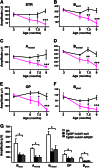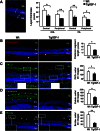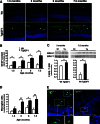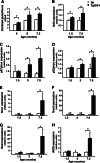Insulin-like growth factor I (IGF-I)-induced chronic gliosis and retinal stress lead to neurodegeneration in a mouse model of retinopathy
- PMID: 23620587
- PMCID: PMC3682564
- DOI: 10.1074/jbc.M113.468819
Insulin-like growth factor I (IGF-I)-induced chronic gliosis and retinal stress lead to neurodegeneration in a mouse model of retinopathy
Abstract
Insulin-like growth factor I (IGF-I) exerts multiple effects on different retinal cell types in both physiological and pathological conditions. Despite the growth factor's extensively described neuroprotective actions, transgenic mice with increased intraocular levels of IGF-I showed progressive impairment of electroretinographic amplitudes up to complete loss of response, with loss of photoreceptors and bipolar, ganglion, and amacrine neurons. Neurodegeneration was preceded by the overexpression of genes related to retinal stress, acute-phase response, and gliosis, suggesting that IGF-I altered normal retinal homeostasis. Indeed, gliosis and microgliosis were present from an early age in transgenic mice, before other alterations occurred, and were accompanied by signs of oxidative stress and impaired glutamate recycling. Older mice also showed overproduction of pro-inflammatory cytokines. Our results suggest that, when chronically increased, intraocular IGF-I is responsible for the induction of deleterious cellular processes that can lead to neurodegeneration, and they highlight the importance that this growth factor may have in the pathogenesis of conditions such as ischemic or diabetic retinopathy.
Keywords: Animal Models; Glia; Insulin-like Growth Factor (IGF); Neurodegeneration; Retina.
Figures









Similar articles
-
Increased intraocular insulin-like growth factor-I triggers blood-retinal barrier breakdown.J Biol Chem. 2009 Aug 21;284(34):22961-9. doi: 10.1074/jbc.M109.014787. Epub 2009 May 27. J Biol Chem. 2009. PMID: 19473988 Free PMC article.
-
Inhibition of Protein Tyrosine Phosphatase 1B Improves IGF-I Receptor Signaling and Protects Against Inflammation-Induced Gliosis in the Retina.Invest Ophthalmol Vis Sci. 2015 Dec;56(13):8031-44. doi: 10.1167/iovs.15-17234. Invest Ophthalmol Vis Sci. 2015. PMID: 26720454
-
Differential effects of P2Y1 deletion on glial activation and survival of photoreceptors and amacrine cells in the ischemic mouse retina.Cell Death Dis. 2014 Jul 31;5(7):e1353. doi: 10.1038/cddis.2014.317. Cell Death Dis. 2014. PMID: 25077539 Free PMC article.
-
Müller Glia Reactivity and Development of Gliosis in Response to Pathological Conditions.Adv Exp Med Biol. 2018;1074:303-308. doi: 10.1007/978-3-319-75402-4_37. Adv Exp Med Biol. 2018. PMID: 29721957 Review.
-
Expression and signaling of NGF in the healthy and injured retina.Cytokine Growth Factor Rev. 2017 Apr;34:43-57. doi: 10.1016/j.cytogfr.2016.11.005. Epub 2016 Dec 2. Cytokine Growth Factor Rev. 2017. PMID: 27964967 Review.
Cited by
-
Targeting Microglia to Treat Degenerative Eye Diseases.Front Immunol. 2022 Feb 17;13:843558. doi: 10.3389/fimmu.2022.843558. eCollection 2022. Front Immunol. 2022. PMID: 35251042 Free PMC article. Review.
-
C1q/TNF-Related Protein 3 Prevents Diabetic Retinopathy via AMPK-Dependent Stabilization of Blood-Retinal Barrier Tight Junctions.Cells. 2022 Feb 23;11(5):779. doi: 10.3390/cells11050779. Cells. 2022. PMID: 35269401 Free PMC article.
-
Eye on the horizon: The metabolic landscape of the RPE in aging and disease.Prog Retin Eye Res. 2025 Jan;104:101306. doi: 10.1016/j.preteyeres.2024.101306. Epub 2024 Oct 19. Prog Retin Eye Res. 2025. PMID: 39433211 Free PMC article. Review.
-
Increased Susceptibility to Cerebral Microhemorrhages Is Associated With Imaging Signs of Microvascular Degeneration in the Retina in an Insulin-Like Growth Factor 1 Deficient Mouse Model of Accelerated Aging.Front Aging Neurosci. 2022 Mar 9;14:788296. doi: 10.3389/fnagi.2022.788296. eCollection 2022. Front Aging Neurosci. 2022. PMID: 35356301 Free PMC article.
-
Diabetic Retinopathy: Animal Models, Therapies, and Perspectives.J Diabetes Res. 2016;2016:3789217. doi: 10.1155/2016/3789217. Epub 2016 Jan 6. J Diabetes Res. 2016. PMID: 26881246 Free PMC article. Review.
References
-
- Laviola L., Natalicchio A., Giorgino F. (2007) The IGF-I signaling pathway. Curr. Pharm. Des. 13, 663–669 - PubMed
-
- Shaw L. C., Grant M. B. (2004) Insulin-like growth factor-1 and insulin-like growth factor binding proteins: their possible roles in both maintaining normal retinal vascular function and in promoting retinal pathology. Rev. Endocr. Metab. Disord. 5, 199–207 - PubMed
-
- Inokuchi N., Ikeda T., Imamura Y., Sotozono C., Kinoshita S., Uchihori Y., Nakamura K. (2001) Vitreous levels of insulin-like growth factor-I in patients with proliferative diabetic retinopathy. Curr. Eye Res. 23, 368–371 - PubMed
-
- Smith L. E., Shen W., Perruzzi C., Soker S., Kinose F., Xu X., Robinson G., Driver S., Bischoff J., Zhang B., Schaeffer J. M., Senger D. R. (1999) Regulation of vascular endothelial growth factor-dependent retinal neovascularization by insulin-like growth factor-1 receptor. Nat. Med. 5, 1390–1395 - PubMed
Publication types
MeSH terms
Substances
LinkOut - more resources
Full Text Sources
Other Literature Sources
Medical
Molecular Biology Databases

